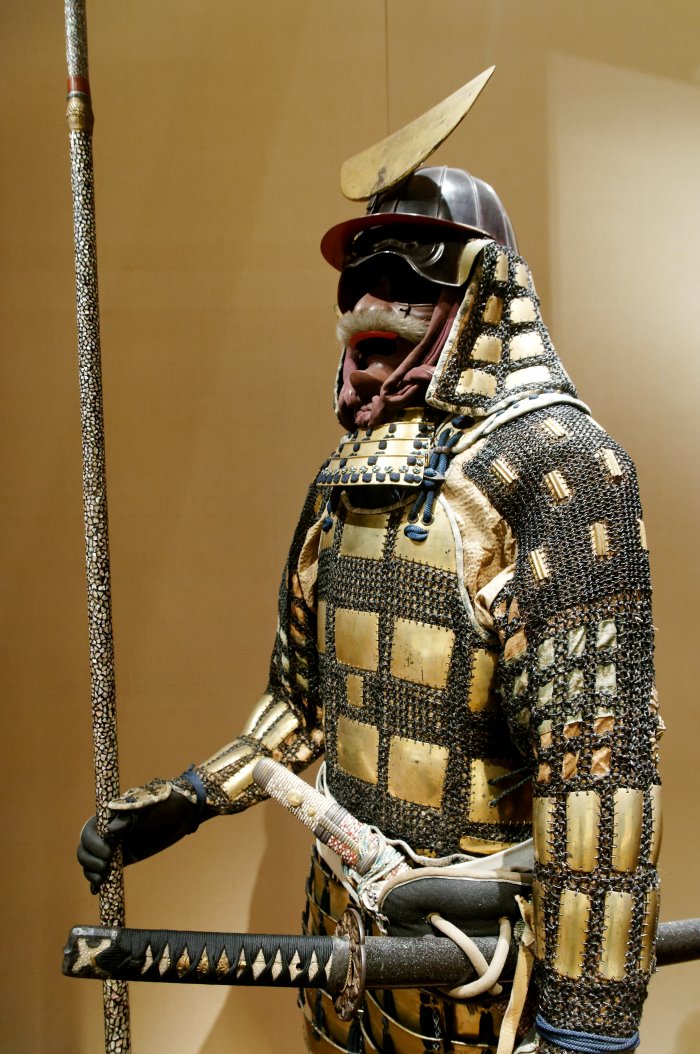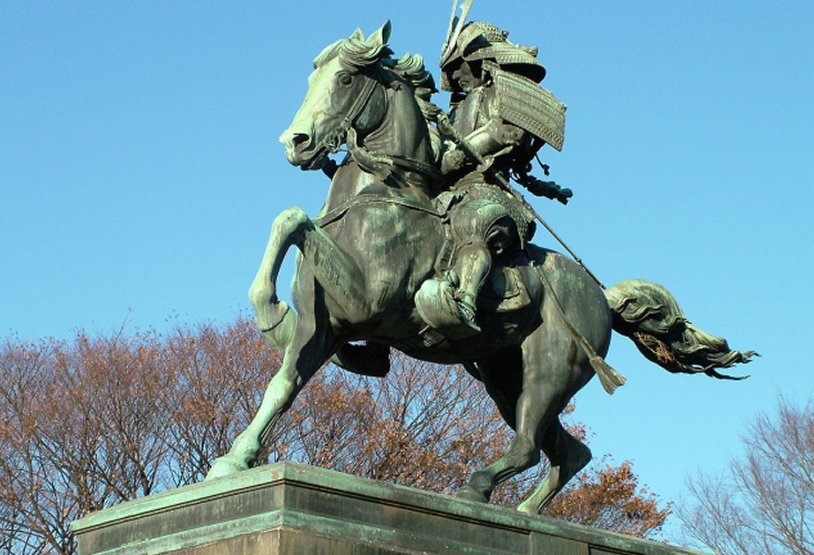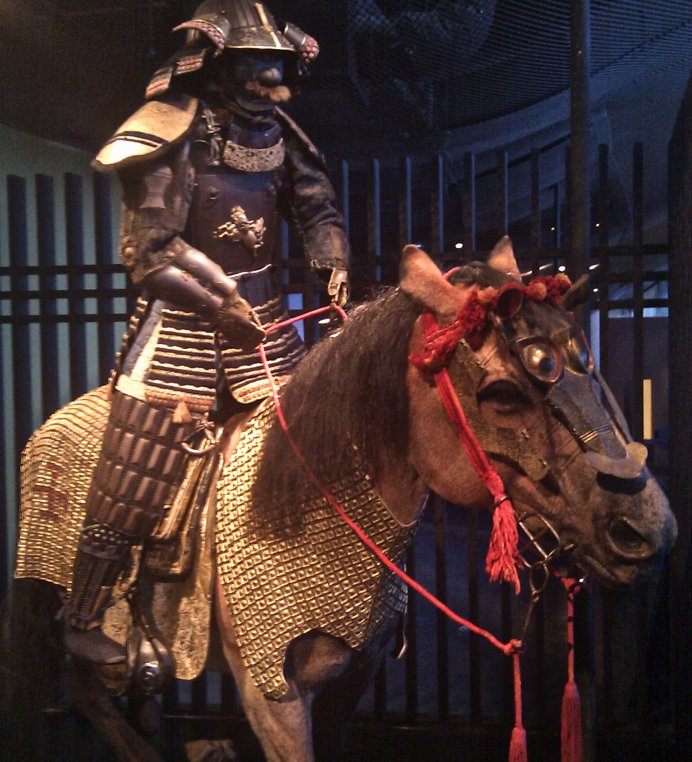Samurai – Powerful Skilled Warriors Who Loved Music, Art And Poetry
A. Sutherland - AncientPages.com - The samurai were the legendary warriors of old Japan who led noble but violent lives governed by the demands of honor, personal integrity, and loyalty.
Japanese folding armor (tatami gusoku), Edo period. - Karuta tatami do gusoku, Edo period. A lightweight portable folding (tatami) armour made from small square or rectangle armor plates called karuta. The karuta are usually connected to each other by chainmail and sewn to a cloth backing. Image credit: Marie-Lan Nguyen - CC BY 2.5
Members of the warrior class in Japan from 1185-1867, Samurai (means "one who serves"), lived by the Bushido Code and were willing to give their lives to defend their honor. They were the well-paid retainers of the daimyo, powerful Japanese feudal lords during the Middle Ages in Japan.
An emperor and his family officially ruled the country, but respective areas were governed by the 'daimyo' military generals and powerful warlords with strong armies of fighters.
The Daimyo lords belonged to the Samurai class, the highest caste, until the abolition of the caste. They reported directly to the shogun, and their status was counted in the so-called 'koku,' a measure of how much rice their country could produce. After the famous battle at Sekigahara in 1600, the daimyo was divided into two groups: tozama and fudai, depending on which side they were on this battle.
These men had at their disposal large, formidable armies and were often in conflict with each other.
At the head of their military forces were some of the bravest and most terrifying warriors - the 'samurai' (which means' ones who serve'), highly respected for their extraordinary skills and courageous nature of warriors.
Statue of samurai Kusunoki Masashige stationed outside Tokyo Imperial Palace. Image credit: David Moore - CC BY-SA 2.5
The samurai lived at the top of a strictly layered society (made up of individuals, families, and groups in society) and controlled political power and wealth.
The Samurai class existed in Japan for over a thousand years. The Samurai has quite a fascinating history. They started in the 1100s and ended their existence in 1835.
The samurai were not considered part of the aristocracy. Instead, they served as mercenary tools, helping competing groups within the elite. Their military success for the aristocratic families, on the other hand, resulted in grants of considerable parcels of land to these noble families.
Subsequently, this land came under the administration of their samurai vassals, and eventually, the land came under samurai control as payment for their services. It was a gift because the samurai supported rich and influential daimyo and fought for them. Peasants who worked on these given lands had to pay taxes for money and food to support their masters.
It reminds us of warriors and knights of Medieval Europe, as we described earlier in one of the articles on Ancient Pages.
A samurai was expected to show reckless courage, fairness, reverence for the gods, and generosity toward those weaker. At the heart of all Samurai, training was the 'Bushido Code,' a strict creed – 'Way of the Warrior.'
Dying an honorable death was judged more important than living a long life.
A re-creation of an armored samurai riding a horse, showing horse armour (uma yoroi or bagai), from The Musée du Quai Branly, Paris France, the collection of samurai armor from The Ann and Gabriel Barbier-Mueller Museum, Dallas. source
For decades, Samurai armies were engaged in power struggles and battles between various factions. By the late 12th century, the samurai's power had become dominant. In this new situation, the emperor established the first shogun or military dictator. As a result, powerful samurai would rule Japan for most of the next seven centuries.
"The establishment of martial rule and ascension of Samurai as the dominant class would have far-reaching effects on the development of Japanese society. Samurai political dominance exerted influence not only in the areas of ruler and lawgivers but also as patrons in the fields of education and the arts." 1
Surprisingly, despite their excellent skills in battle, the samurai loved music, art, and poetry. Many samurai were deeply interested in Zen Buddhism, an essential force in Japan, especially after the 12th century. It had considerable influence on Japanese culture, far beyond the temple. It successfully reached cultural and social areas of all kinds, including gardening, ink painting, calligraphy, the tea ceremony, and even military strategies.
The samurai preferred hand-to-hand combat using razor-sharped swords.
As their fighting style was based on quick movements, it was vital for them to have only light armor-decorated helmets for cheek and neck protection. Additional armor included frightening masks and shoulder plates (of leather, wood, and later steel), usually tied to breastplates, for better body protection.
Underneath his armor, the Samurai usually would wear a baggy garment, loose pants, and a kimono on top of that.
The samurai did not use shields; instead, they used the sides of their swords to neutralize an enemy attack.
Written by – A. Sutherland AncientPages.com Staff Writer
Updated on Nov 4, 2023
Copyright © AncientPages.com All rights reserved. This material may not be published, broadcast, rewritten or redistributed in whole or part without the express written permission of AncientPages.com
Expand for referencesMore From Ancient Pages
-
 Discovery Of Chromosomes Offers Evidence Of Ancient Humans Living In South America Over 18,000 Years Ago
Archaeology | Aug 21, 2022
Discovery Of Chromosomes Offers Evidence Of Ancient Humans Living In South America Over 18,000 Years Ago
Archaeology | Aug 21, 2022 -
 LIDAR Discovers Giant Ancient Mesoamerican Calendar – Structures Were Aligned To The Stars
Archaeoastronomy | Jan 10, 2023
LIDAR Discovers Giant Ancient Mesoamerican Calendar – Structures Were Aligned To The Stars
Archaeoastronomy | Jan 10, 2023 -
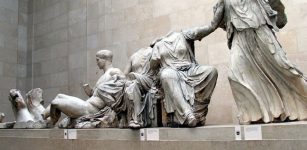 Parthenon Marbles: MEPs Call On Boris Johnson To Return Treasures To Greece
Artifacts | Nov 19, 2020
Parthenon Marbles: MEPs Call On Boris Johnson To Return Treasures To Greece
Artifacts | Nov 19, 2020 -
 Was Alulim, First King Of Sumer And Eridu Biblical Adam?
Featured Stories | Mar 14, 2019
Was Alulim, First King Of Sumer And Eridu Biblical Adam?
Featured Stories | Mar 14, 2019 -
 Major Puzzle In Mammal Skull Shape Evolution Solved
Evolution | Dec 20, 2023
Major Puzzle In Mammal Skull Shape Evolution Solved
Evolution | Dec 20, 2023 -
 On This Day In History: Mysterious Death Of White Queen Anne Neville – On Mar 16, 1485
News | Mar 16, 2017
On This Day In History: Mysterious Death Of White Queen Anne Neville – On Mar 16, 1485
News | Mar 16, 2017 -
 Advanced Flying Machines And Interplanetary Travel Described 7000 Years Ago In India
Civilizations | Aug 20, 2015
Advanced Flying Machines And Interplanetary Travel Described 7000 Years Ago In India
Civilizations | Aug 20, 2015 -
 Could Vancouver Island’s Hepburn Stone Be 15,000 Years Old?
Artifacts | Feb 20, 2021
Could Vancouver Island’s Hepburn Stone Be 15,000 Years Old?
Artifacts | Feb 20, 2021 -
 Mystery Of The Tower Of Babel – The Mountain Of God Or A Symbol Of Chaos And Ignorance?
Ancient Mysteries | Oct 14, 2014
Mystery Of The Tower Of Babel – The Mountain Of God Or A Symbol Of Chaos And Ignorance?
Ancient Mysteries | Oct 14, 2014 -
 On This Day In History: The Mongol Conqueror Genghis Khan Died – On August 18, 1227
News | Aug 18, 2016
On This Day In History: The Mongol Conqueror Genghis Khan Died – On August 18, 1227
News | Aug 18, 2016 -
 Incredibly Well-Preserved Viking Age Ski Discovered Under Melting Ice
Archaeology | Nov 8, 2022
Incredibly Well-Preserved Viking Age Ski Discovered Under Melting Ice
Archaeology | Nov 8, 2022 -
 Persephone: Greek Goddess Of The Coming Spring And Lady Of The Land Of The Dead
Featured Stories | Jun 26, 2021
Persephone: Greek Goddess Of The Coming Spring And Lady Of The Land Of The Dead
Featured Stories | Jun 26, 2021 -
 Forgotten Notebook Reveals Da Vinci Understood Gravitiy Long Before Newton
Ancient Technology | Feb 22, 2023
Forgotten Notebook Reveals Da Vinci Understood Gravitiy Long Before Newton
Ancient Technology | Feb 22, 2023 -
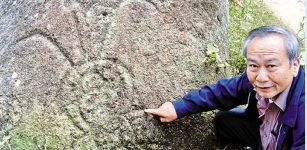 Extraterrestrial Visit Recorded On Stone: They Came From The Stars
Featured Stories | May 4, 2014
Extraterrestrial Visit Recorded On Stone: They Came From The Stars
Featured Stories | May 4, 2014 -
 Unsolved Archaeological Mystery Of Ta Prohm Temple, Cambodia
Civilizations | Sep 3, 2018
Unsolved Archaeological Mystery Of Ta Prohm Temple, Cambodia
Civilizations | Sep 3, 2018 -
 Apollo – Loved And Feared Greek God Of Divination And Prophecy Who Was Also Seer Of Zeus
Featured Stories | Feb 6, 2019
Apollo – Loved And Feared Greek God Of Divination And Prophecy Who Was Also Seer Of Zeus
Featured Stories | Feb 6, 2019 -
 Huge Gallo-Roman Amphitheater Of Saintes Will Be Saved For Future Generations – New Project Started
News | Jan 23, 2021
Huge Gallo-Roman Amphitheater Of Saintes Will Be Saved For Future Generations – New Project Started
News | Jan 23, 2021 -
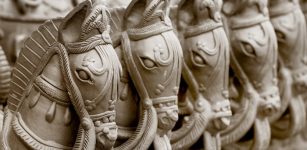 Legendary Uchchaihshravas: Divine Seven-Headed Flying Horse Of God Indra
Featured Stories | May 1, 2017
Legendary Uchchaihshravas: Divine Seven-Headed Flying Horse Of God Indra
Featured Stories | May 1, 2017 -
 Wreck Of Historic Royal Ship ‘Gloucester’ Discovered Off The English Coast
Archaeology | Jun 10, 2022
Wreck Of Historic Royal Ship ‘Gloucester’ Discovered Off The English Coast
Archaeology | Jun 10, 2022 -
 Rare Ancient Leopard Painting Discovered On Sarcophagus In Aswan, Egypt
Archaeology | Feb 25, 2020
Rare Ancient Leopard Painting Discovered On Sarcophagus In Aswan, Egypt
Archaeology | Feb 25, 2020

